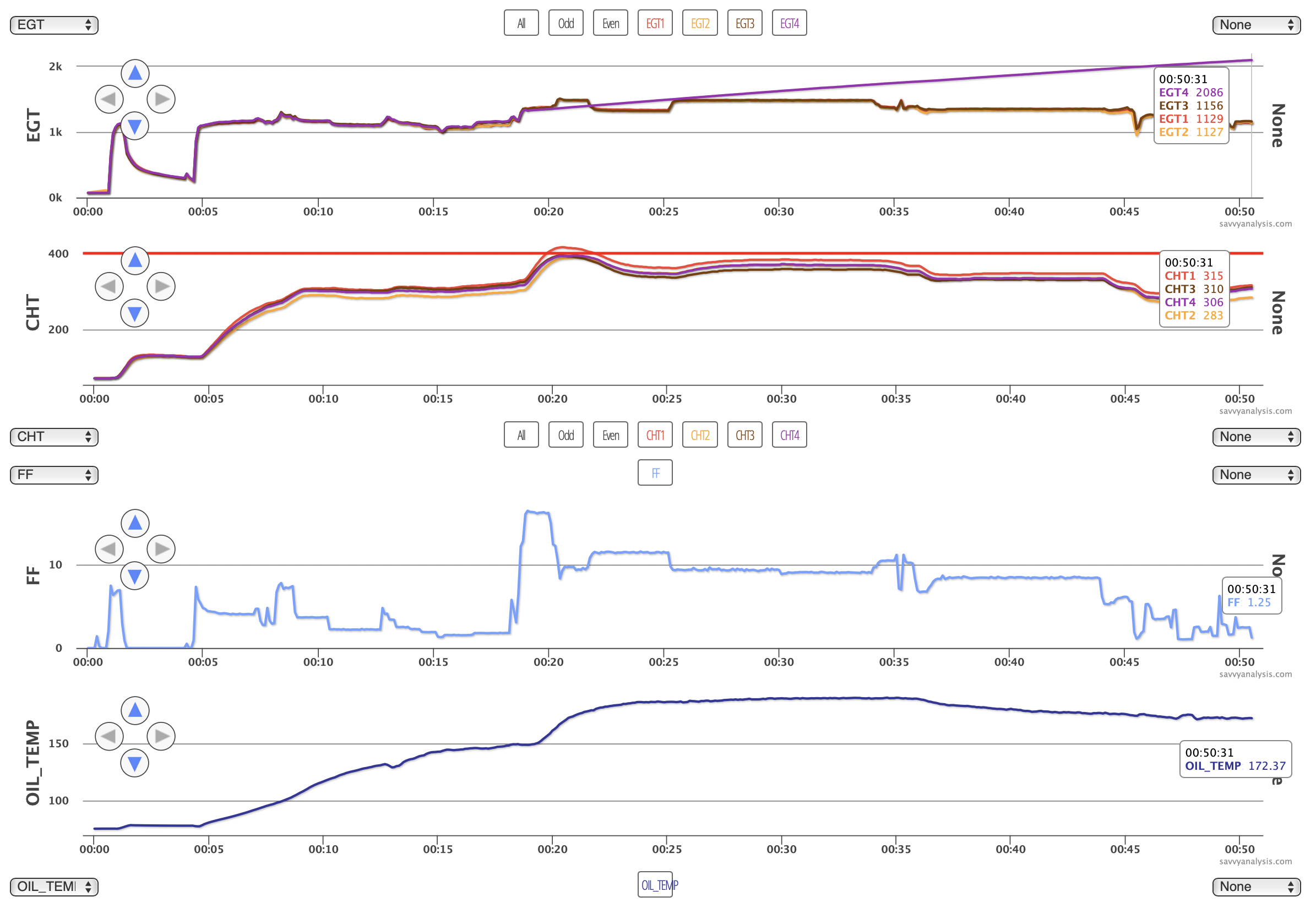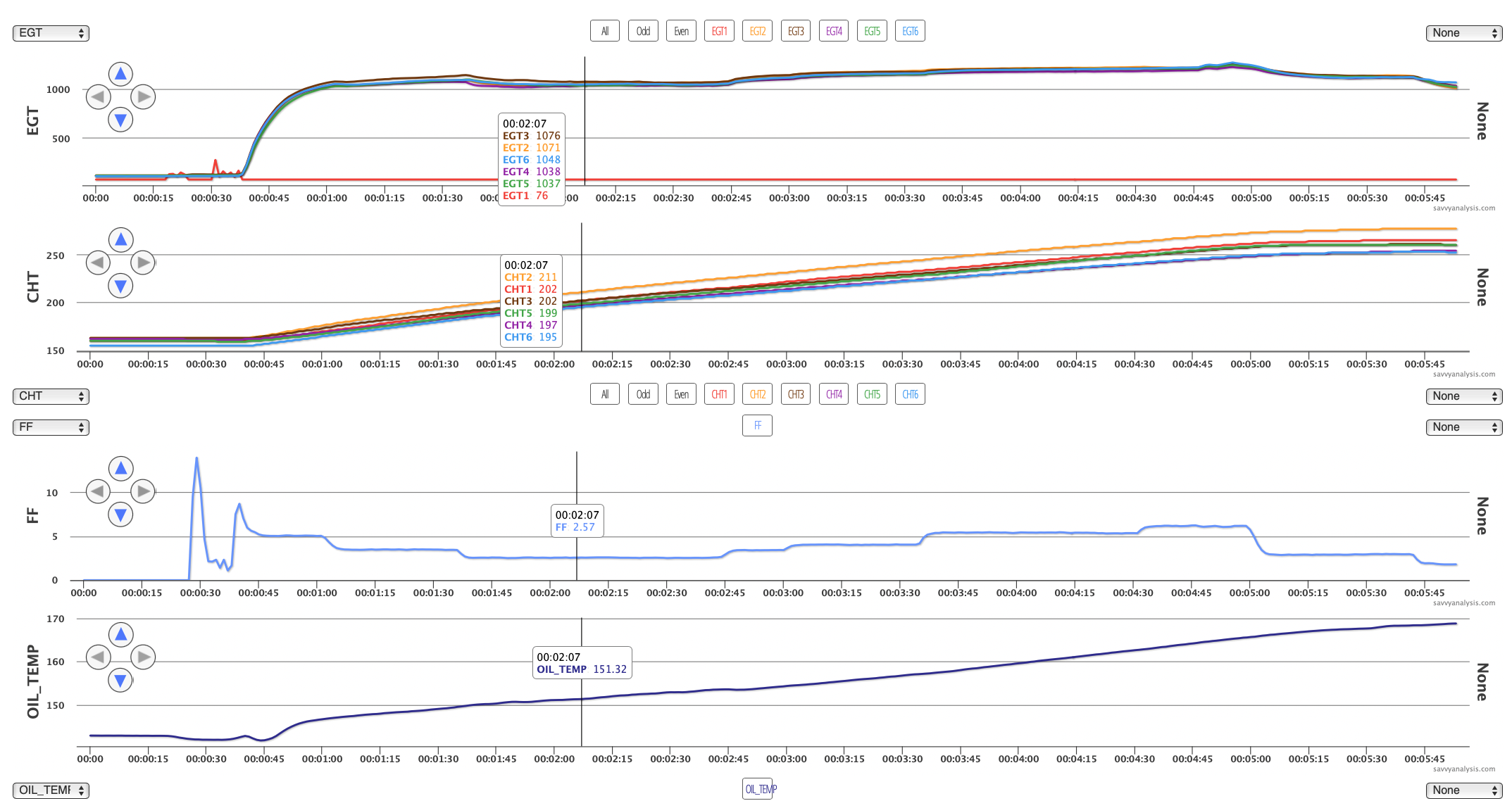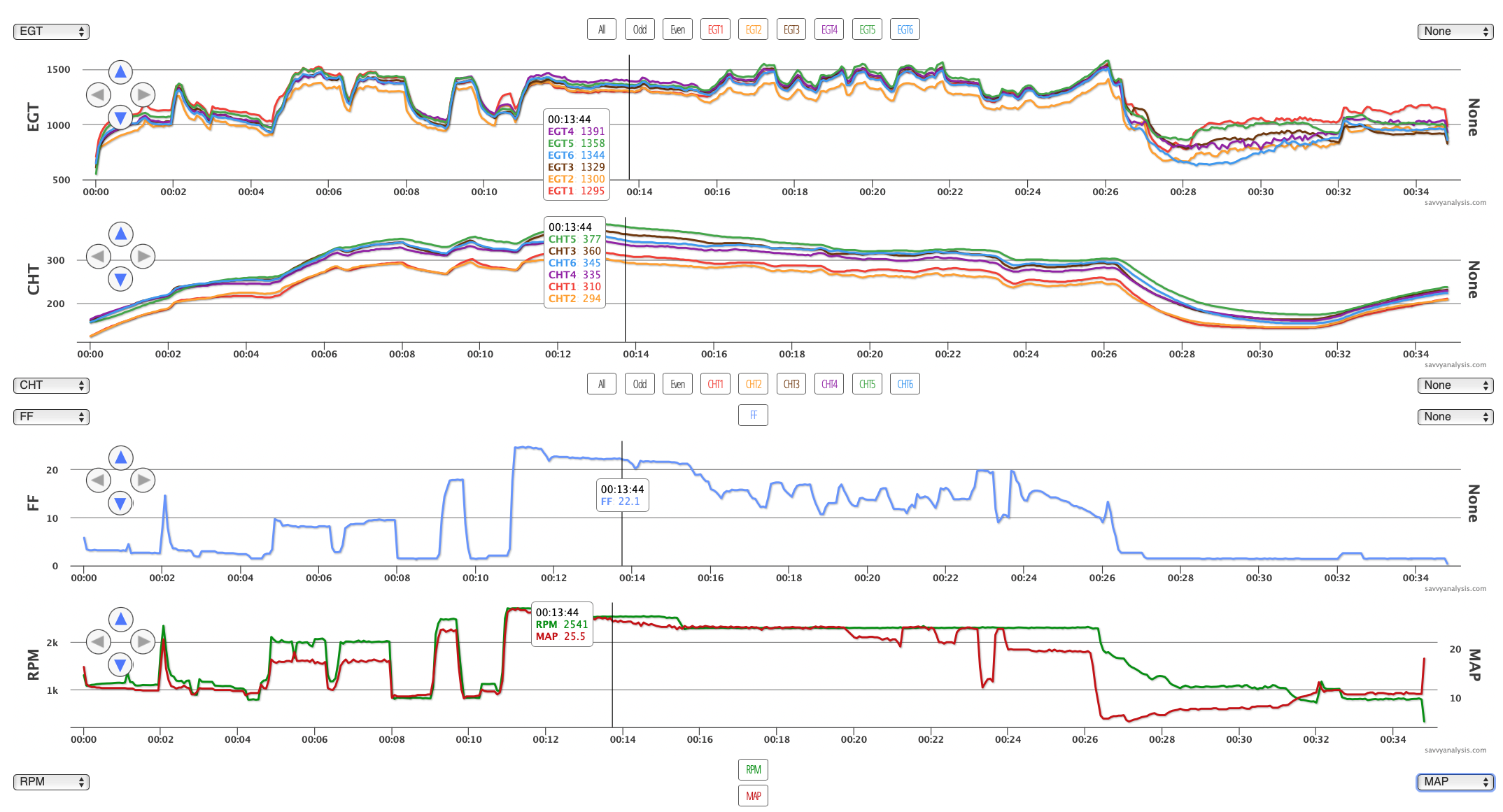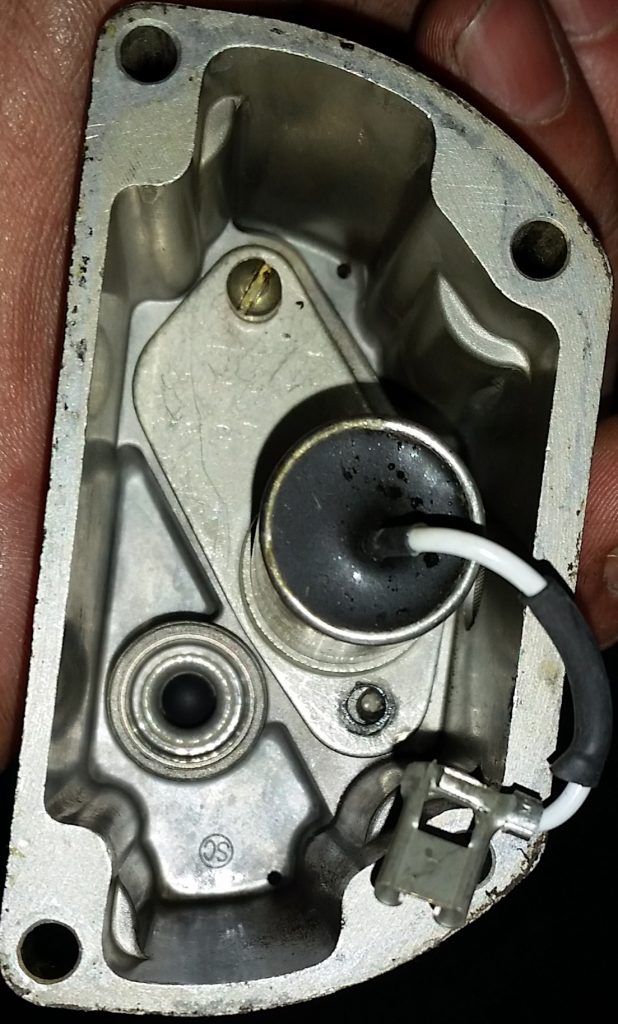If zero tolerance means we won’t tolerate anything but a zero, then I guess zero zero tolerance means we won’t tolerate any zeros. Usually a zero on an engine data monitor isn’t a good thing unless it has an integer or a decimal point in front of it. 40, 300, 2700, 14.0 – all ok. 0 by itself means something isn’t working. The only parameters I can think of where you’d want a zero are the EGT spread or the CHT spread – the difference between highest and lowest – and you’re not likely to ever see that.
Some friends recently sent me a link for the You Tube video of the Cessna 210 out of KCGF making an emergency landing about 90 minutes into their flight from northeast OH to north FL. I hadn’t seen it, and for those of you that haven’t I won’t give away the details, except to reveal that the #4 cylinder vibrates, then both EGT and CHT 4 go dark. Kudos to SuperRook for handling the emergency, especially with valuable cargo on board, and for making and sharing the video. The image that sticks with me is the engine data monitor showing no EGT or CHT coming from cyl 4. Let’s see what we can learn from this month’s collection of data.
First up is data from a Diamond DA40 with a Lycoming IO-360 and data from a Garmin 1000 with a 1 sec sample rate. Layout is my default of EGTs, then CHTs, then FF then oil temp.

Everything looks ok until the takeoff at the 20 min mark, then EGT 4 – the purple trace – starts climbing. Other EGTs rise, then fall, then rise again and 4 isn’t hearing any of it as it cuts a swath through the teen-thousands on its way to 2086º. It’s a 50 min flight and you have to wonder if the flight were longer would it have just kept climbing?
Meanwhile, nothing about CHT 4 or the other CHTs suggests worsening engine trouble, and oil temp even drops a little as the flight continues. I used our ∆/time tool on the EGTs from 19 mins to the end of data —
Time: 00:19:11-00:50:01
EGT1: 1358°, -7.5°/min
EGT2: 1349°, -7.0°/min
EGT3: 1350°, -6.4°/min
EGT4: 1324°, 24.4°/min
The rate of climb for EGT 4 is 24-27º/min pretty much anywhere you click. Just to – ahem – exhaust the possibilities, a bad plug should send EGT higher, but instantly. Ditto a bad mag, but you should see it in more than one EGT. A stuck valve might give you a high EGT but the CHT for that cyl should drop a lot since it’s not making power. And there was no report of roughness in the comments of the analysis request.
It’s easy to spot the straight line and dismiss the data in post-flight analysis. In real time, this would be more distracting than a parameter that went high or low and stayed there. This continual rise might have you at least considering the melting point of valves and exhaust stacks. Our recommendation was to check the probe and connection – the odd thing is the next time the pilot fired up the engine the EGT 4 probe tracked normally, and has done so ever since.
Next is data from a Cirrus SR20 with a Continental IO-360 and data from an Avidyne with a 6 sec sample rate. Again, layout is my default of EGTs, then CHTs, then FF then oil temp.

Startup and taxi-out look ok. The runup just before the 4 min mark shows oil temp a little wobbly but still in the game. Then when power is applied at the 7 min mark, oil temp drops. Not just to zero, which would have been bad enough. This probe’s floor is a balmy -67º which it hits 7 times in this short flight. I didn’t depict oil pressure because it didn’t reveal any clues. It always makes sense to check the connection before replacing the probe, especially the connectors at the firewall on early-model SR20s. In this case cleaning the sensor connection made the data normal again.
Next is a Cirrus SR22 with a Continental IO-550 and data from a Garmin Perspective with a 1 sec sample rate. Once again, layout is my default of EGTs, then CHTs, then FF then oil temp.

This about 6 mins of data for a flight not taken. The issue is EGT 1, the red trace. Its first sample is 76º, then at engine start it jumps over the others, then settles back to 76 and doesn’t move. You might think, as we did, that it’s tracking ambient temperature – but no, ambient is in the 40º C range.
Last month’s Puzzler was about taking off with data you know to be unreliable, and this looks like one where the pilot decided the flight could wait until everything was working again.
We’ll finish up 2018 with a Piper Comanche PA-24 with a Lycoming IO-540 and data from a JPI 830 with a 1 sec sample rate. This time layout is EGTs, then CHTs, then FF then RPMs in green and MAP in red.

Startup and taxi-out are normal. Runup starts about 5 mins and ends about 8, which is certainly not an abbreviated runup. The time, along with EGT 2, the yellow trace, being low could indicate some roughness in the runup. And there’s another EGT rise, along with FF, RPMs and MAP, from 9 to 10 mins. Whatever it was that extended the first runup and triggered a second shorter one, the pilot applies takeoff power at about 11 mins just left of the cursor. RPMs are 2708 so the engine was making full power.
Climbout looks normal, then at about 16 mins the pilot begins a series of FF adjustments. Since MAP and RPMs don’t change there, it looks like the “big pull” – leaning for cruise FF. Except FF never settles, the pilot reports the engine is “surging”, EGT 2 is running low again, and around the 24 min mark the pilot decides to divert and land. The EGTs on taxi-in are very erratic.
Once on the ground, the pilot finds a shop and they proceed with troubleshooting. This flight data doesn’t point to a smoking gun, but does tell us that at takeoff the engine turned 2700, and the range of EGTs and CHTs at takeoff and climb was ok.
Where to start? EGT and CHT 2 are low when FF is lean, but neither is high at max FF, which would suggest an injector clog – we’re not seeing that. Those erratic EGTs after landing suggest it’s more than just cyl 2, and it looks like mag timing should be checked, and that’s what we recommended.
The mechanic at the diverted-to airport decided it was a faulty ignition switch. So they order a switch, install it, and the problem is still there. Then they discover the R mag is 6º retarded vs spec. Once that is adjusted, we get this data from a post-switch-installation and post-mag-timing ground mag check.

The first mag checked – the L mag – looks ok. The second mag checked is firing the top plugs of 1-3-5 higher than expected. And wait, there’s more. These mags were overhauled about three months ago and timing has already been re-adjusted once since the overhaul.
That’s when they decide to open up the R mag and discover that a loose screw caused the plastic cam follower to melt and cause erratic timing that got a little worse each time.

Fly safe over the holidays and we’ll see you with more puzzling data in 2019.